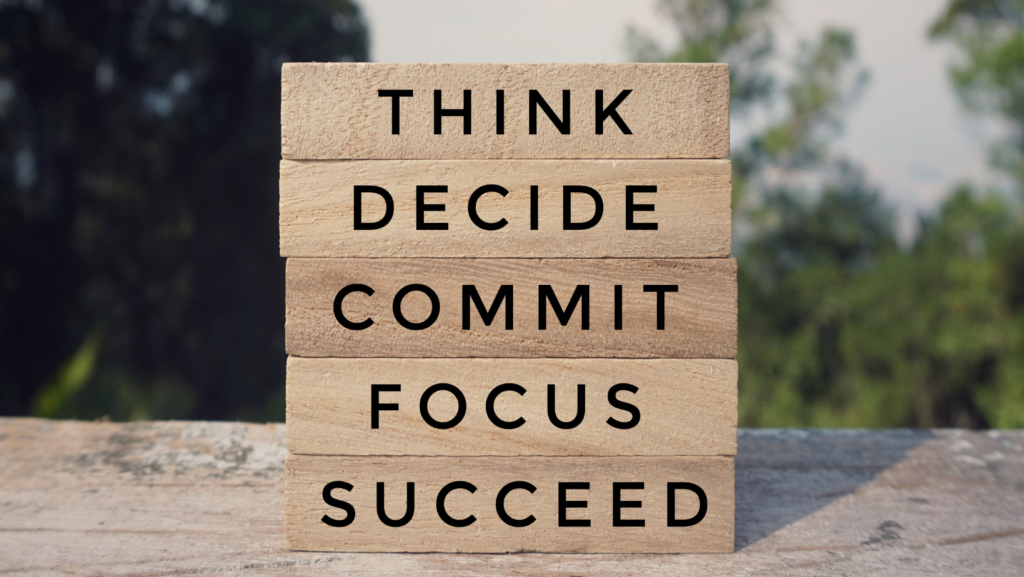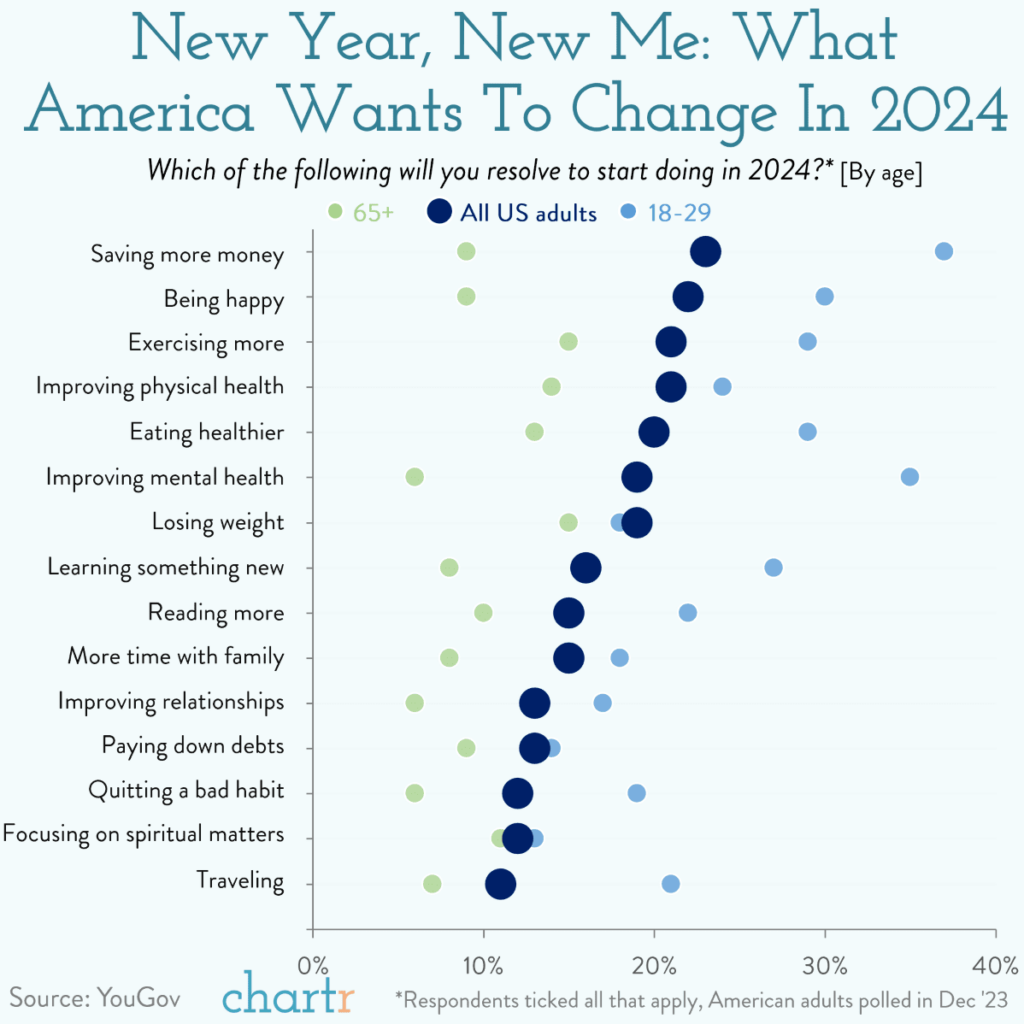Tricks to Keeping Your New Year’s Resolutions

According to history, making new year resolutions dates to Babylonian times, more than 4000 years ago. Somewhat more recently, making resolutions appeared as a phrase in an 1813 Boston newspaper. The article indicated that since people tended to commit all sorts of “sins” in December, the turn of the new year was a great time to straighten out one’s behavior. Hence, the New Year’s Resolution! These days we often use the New Year to adopt new behaviors in exchange for what we believe may be missing or not serving us well.
Are you curious where you land with respect to making resolutions or changes? According to Chartr, it generally depends on your age. Not surprisingly, Baby boomers prioritize health-related changes. The Gen Z generation (18-29) prioritize saving money and mental health. Interesting.

Nonetheless, when the calendar rolls over it creates an opportunity to look back and look forward. What is working for you and what is no longer serving you?
Making changes that stick
What is the “change” or intention you have outlined for yourself? Is it a big change? Little? Easy? Hard? Whatever it is, start by writing it down and putting it in a visible place; a place where you can be reminded of it regularly. It used to be a yellow sticky note for me, placed directly in front of me on my bathroom mirror. It has now morphed into a line item on my task list that sits there winking at me until I can check it off the list.
Why write them down? Studies show those who write down their goals are more likely to make progress with them. Writing them down helps to clarify our goals. It also helps to create a sense of accountability (see above) and it boosts our motivation. Check out our newest flowchart. It has a sense of humor! (Insert Visual)
Other Tools
Besides writing down goals, other tools that help promote change include SMART goals, accountability partners, coaches, and automation.
SMART GOALS
SMART is an acronym for specific, measurable, achievable, relevant, and time bound. It is a time-tested tool for accountability, and you may already use it for holding others accountable. You don’t have to make all your projects into SMART goals, but it is worth thinking about if you want to ensure that you make progress towards the goals you set for yourself. Here is my SMART goal story.
I once heard Gloria Steinem speak and she was asked “what is the hardest thing for you to do?” Her answer was “lose 10 pounds”. Funny, right? But sometimes those 10 pounds are impossible. Well, that was my goal last year. I just got sick of tight pants. Seriously. Every time I put my pants on they were tight. I tried eating less. I tried working out more. I tried doing both. Nothing! By the way, did I mention I never, ever weigh myself?
So…I started weighing myself. I was about 12 lbs. heavier than I thought!!! (measure) It was painful and depressing. Earlier in the year I hired a nutritionist and started filling out a daily food diary. The app told me everything; the number of calories; nutrients, fat, carbs, etc. The nutritionist told me I needed to eat more protein and fats, less carbs. I tried, but I didn’t lose weight. I now know it was because I was “going through the motions” by recording everything, but not really understanding what the numbers meant.
So, I finally said enough and started educating myself. I listened to podcasts (Peter Attia and others) about eating. More importantly, about eating at my age as well as exercising at my age. What I realized was that snacking was derailing my objective. So was sugar. I learned that the relationship between calories ingested and the macronutrients in them has a direct relationship to my weight. Some calories are better than others. It was right there in front of me. Maybe this should have been obvious from the beginning, but it didn’t resonate in my brain until I was fully conscious about it (the relevant part). I also realized that I needed to walk every single day to burn more calories.
I continued to record my intake (every single chip!) and weigh myself daily (specific & time bound). However, I made better caloric choices. More protein meant I was less hungry. A lot more protein at breakfast meant I was less hungry throughout the day. No naked carbs! Little by little I dropped a 1/2 lb., then another ½, then ¼. It worked. It took me about 4-5 months from my “awakening” until I got to a place where my pants feel comfortable again (achievable). I still weigh myself. Everyday. And I know how to quickly correct if I find my way into the pantry too many times throughout the day.
ACCOUNTABILITY BUDDY
The Buddy system can be a fun and supportive way to hold oneself accountable. Your buddy can be a friend, colleague, partner or spouse. The key is to hold each other accountable for whatever you are trying to accomplish. Pick someone you trust who will be honest in a constructive way.
A COACH
My friend, Vicki, is a leadership coach. I asked her how a coach can be helpful. She shared that a coach is a neutral party who listens deeply and will meet the client where they are emotionally. Coaches generally have a vast box of tools and experience that can help make a difference. Tools can be customized to the individual. Her approach to setting goals with clients includes a process of revealing honest emotions that may hold one back along with desires that move people towards meaning and purpose. Part of her process includes learning the power of saying “No” to focus energy on what is desired. And…paying a coach (I like to say having skin in the game) can be a powerful motivator to move forward.
AUTOMATION
Automation is systematizing a process so that the decision-making to execute is taken out of the equation. For instance, one of the easiest ways to save money is to pay yourself first by automating your weekly/monthly savings deposits. We already do this with our retirement plans. It is easy to implement this tool for other goals, such as a travel fund or an education fund.
Other ways to use automation:
· Set an alarm for a specific time to do something, like working out, meditation or calling a friend
· Systematize meal preparation for the week. How many Reels have you seen of people making 5 overnight oats servings!
· Set up automatic bill payment and never be late again!
Whether making a change is on the table for you as we kick off 2024, being aware of tools and resources to help you achieve goals you set for yourself, now or down the road, can make the process a whole lot easier.
share this post
share on facebook
email to a friend
pin to pinterest